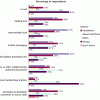Strategic advice to leverage new technologies
Technology is at the heart of nearly every enterprise, enabling new business models and strategies, and serving as the catalyst to industry convergence. Leveraging the right technology can improve business outcomes, providing intelligence and insights that help you make more informed and accurate decisions. From finding patterns in data through data science, to curating relevant insights with data analytics, to the predictive abilities and innumerable applications of AI, to solving challenging business problems with ML, NLP, and knowledge graphs, technology has brought decision-making to a more intelligent level. Keep pace with the technology trends, opportunities, applications, and real-world use cases that will move your organization closer to its transformation and business goals.
Recently Published
Understand the Value Equation
Architects face many challenges in their jobs. Among them are creating architecture and applying architecture. I've said many times that creating architecture alone does not create value. Rather, the value from architecture comes when it is applied. In other words, value is delivered when architecture is used to influence the outcome of decision making, analysis, design, or implementation. Yet another challenge is that architects are often not the people who are responsible for doing the applying.
Understand the Value Equation
Architects face many challenges in their jobs. Among them are creating architecture and applying architecture. I've said many times that creating architecture alone does not create value. Rather, the value from architecture comes when it is applied. In other words, value is delivered when architecture is used to influence the outcome of decision making, analysis, design, or implementation.
If You Build It, They May Not Come
With apologies to people who loved the 1989 movie Field of Dreams, starring Kevin Costner, the title above is an easy metaphor for what often happens these days when an organization attempts to develop and launch its own social network: it builds it, opens it with a fanfare ... and almost no one comes to the party.
Adopting Open Source Software Tools and Techniques: Part II
This is the second Executive Update in a three-part series looking at the extent to which organizational software development teams are using the tools and techniques associated with open source software projects. The series is based on data from a survey Cutter conducted in late 2010.
Experienced coaches may have observed this effect: after one or two years of agile transition, the team is working really well.
There's been a lot of talk about the need for organizations to enable their employees to access, view, and interact with corporate data using mobile devices such as smartphones (iPhones, BlackBerrys, Android-based, etc.) and tablet devices (iPad, PlayBook, etc.) via reports, interactive dashboards, data visualization, ad hoc reporting, and other BI functionality.













